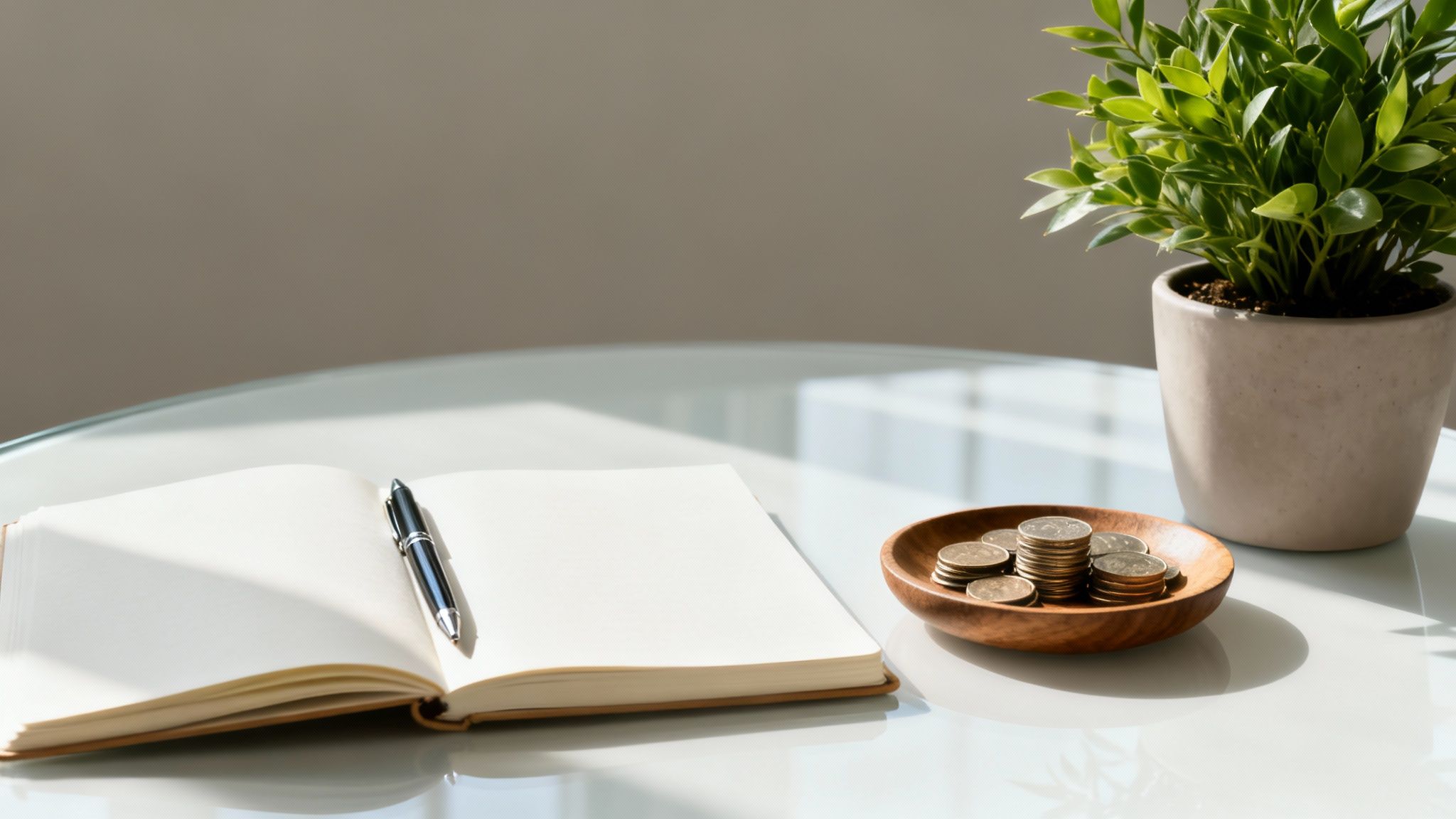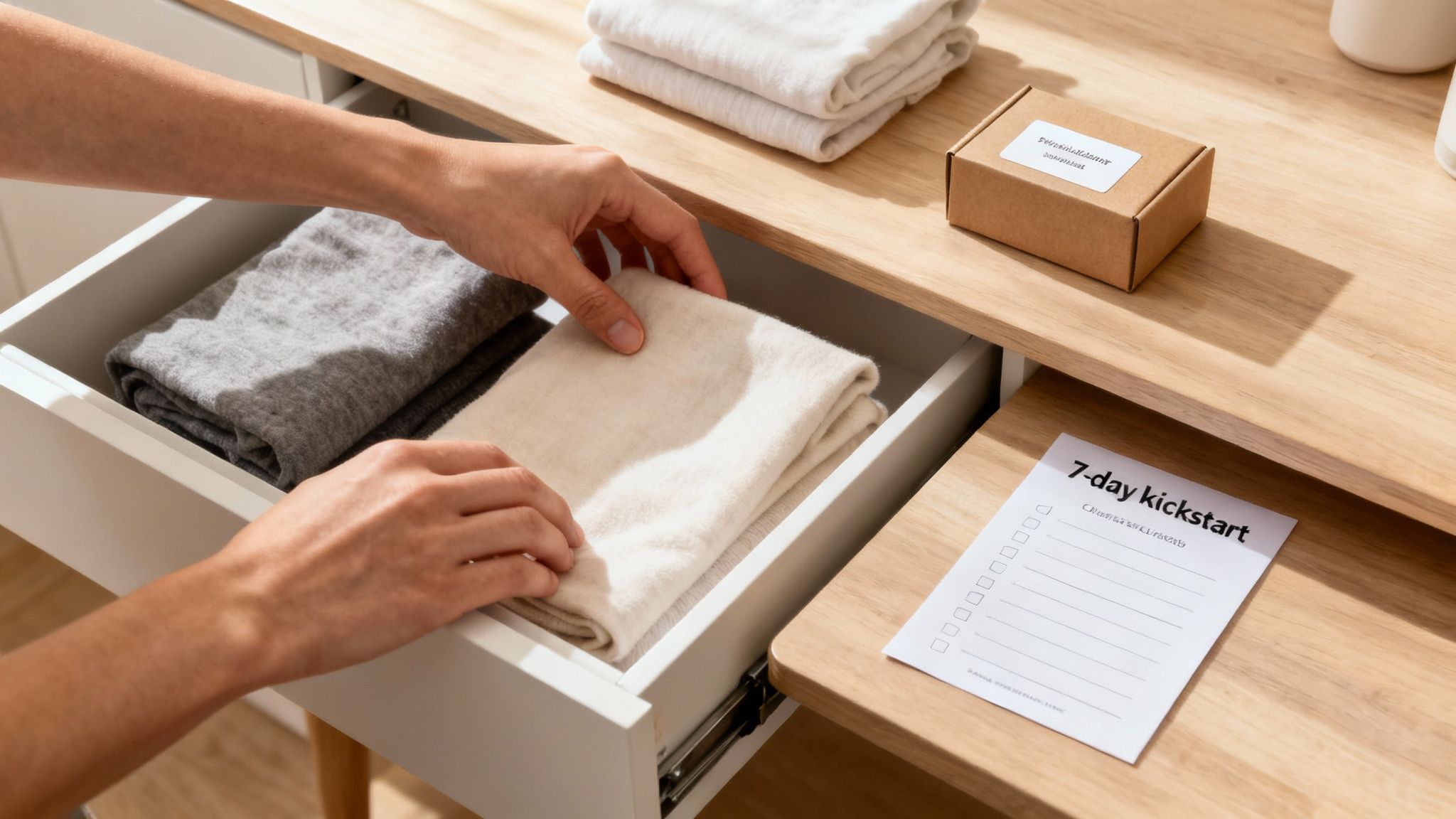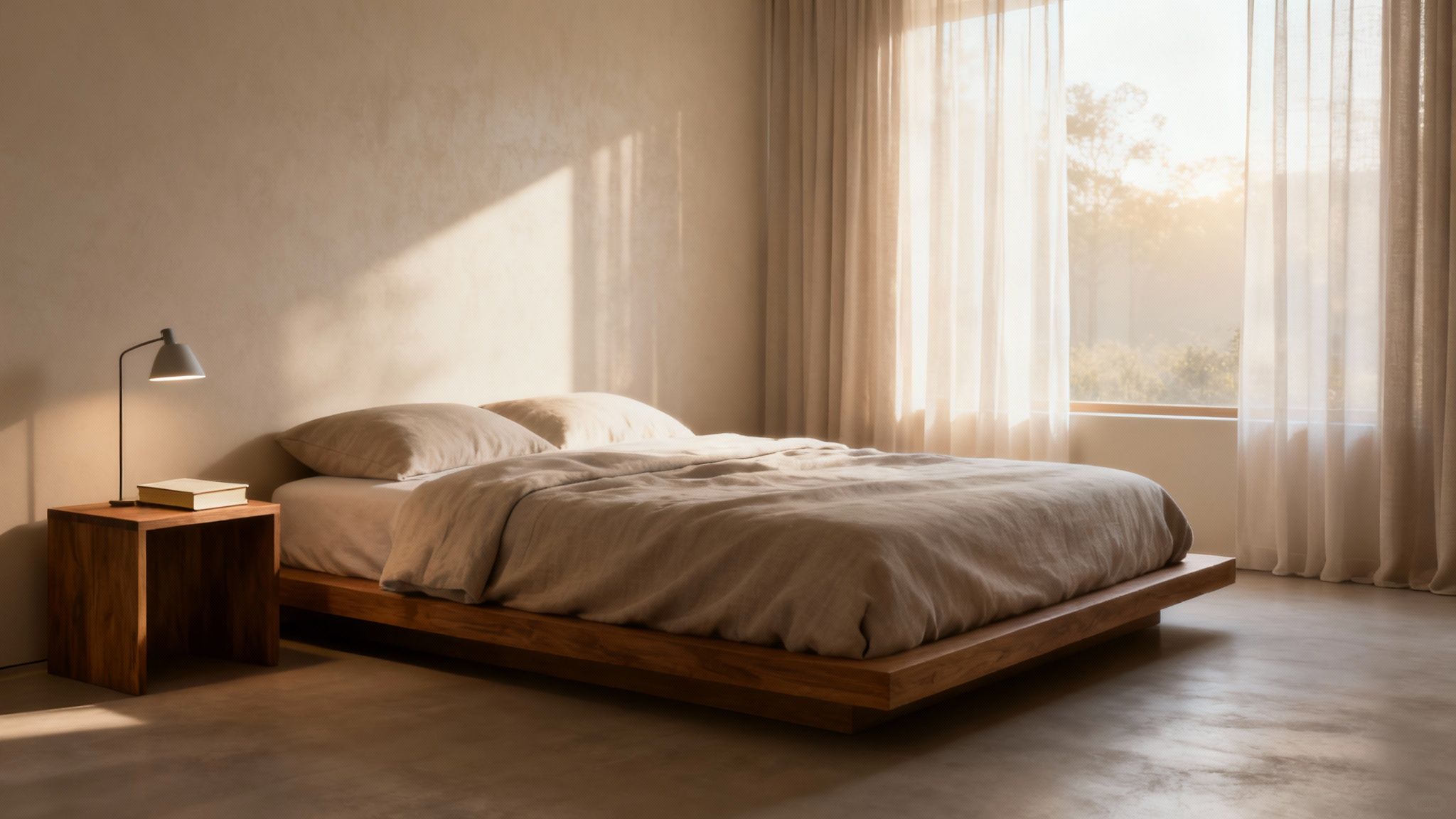Minimalist living is the inspiring, intentional practice of living with only the things you truly need and love. It’s about consciously clearing away the excess in your life—whether it’s physical clutter, draining commitments, or mental noise—to finally make room for what genuinely brings you joy.
Think of it as a deliberate choice for less to unlock a life of more—more freedom, more time, and more purpose.
Unlocking a Life of Purpose
Ever feel like your mind is a smartphone with too many apps running in the background? It’s slow, the battery drains in a flash, and you can’t focus on what you actually need to do. Minimalist living is your chance to close those unnecessary tabs. It's a powerful mindset shift, not a rigid rulebook about owning a specific number of things or living in a sterile white box.
At its core, this lifestyle is about intentionality. It challenges you to ask one powerful question about everything you own, do, and commit to: “Does this add value to my life?”
By answering that question honestly, you begin to design a life that truly reflects your priorities and passions. This is where minimalism overlaps with intentional living, a concept you can explore more deeply right here: https://mesmos.co/blogs/news/what-is-intentional-living.

The True Meaning of Minimalism
Minimalism isn’t about what you remove; it’s about what you gain in its place. The whole idea is to clear away distractions to create space for richer relationships, meaningful experiences, and personal growth. It's trading a life of mindless consumption for one of genuine connection and contribution.
Research from the Journal of Consumer Psychology even backs this up, showing that voluntarily simplifying and reducing consumption can lead to higher life satisfaction and a more optimistic outlook. If you're ready to dive in, you might find inspiration in a step-by-step guide to starting minimalism.
We often hear some wild misconceptions about what it means to be a minimalist. Let’s clear a few of those up.
Minimalism At a Glance
| Misconception | Reality |
|---|---|
| It’s about getting rid of everything. | It's about keeping what truly serves you. |
| It means living in a cold, empty home. | It's about creating a warm, intentional space. |
| It’s only for single people with no kids. | It can be adapted for any lifestyle or family size. |
| It means you can’t buy anything new. | It means you buy with intention and purpose. |
Ultimately, minimalism is a tool, not a destination. It’s a way to design a life that feels authentic to you.
“Clutter is not just physical stuff. It’s old ideas, toxic relationships, and bad habits. Clutter is anything that does not support your better self.” - Eleanor Brown
This lifestyle is your permission slip to stop chasing “more” and start defining what “enough” means for you. By embracing minimalism, you aren't depriving yourself—you're liberating yourself to live a more focused, joyful, and authentic life.
The Life-Changing Benefits of Living with Less
Deciding to live with less is like stepping out of a noisy, crowded room and into a quiet, open field. Suddenly, you can breathe deeper and think more clearly. The benefits aren't just about a tidy home—they ripple through every corner of your life, creating positive changes that you can truly feel.
This isn't just about aesthetics; it's a powerful way to reclaim your well-being. By intentionally removing the things that don't add value, you make space for incredible mental, financial, and even environmental rewards.

Find Your Mental Clarity
Have you ever noticed how physical clutter mirrors mental clutter? It's not just a feeling. A study from Princeton University found that a disorganized environment overloads your visual cortex, making it harder to focus and complete tasks. When your space is chaotic, your mind follows, leaving you feeling anxious and overwhelmed.
Minimalism acts like a reset button for your brain. By surrounding yourself with only items you truly love and use, you cut down on visual noise and decision fatigue that drains your energy. This creates the mental space you need to be creative, focused, and relaxed. You can dive deeper into the benefits of a tidy work and home environment in our other guide.
Action Point: Take 10 minutes to clear one flat surface completely, like your desk or coffee table. Notice the immediate sense of calm.
Achieve Financial Freedom
Imagine what you could do with the money you once spent on impulse buys and unnecessary "stuff." That's the real financial power of minimalism. When you shift your focus from mindless consumption to conscious purchasing, you naturally start spending less and saving more.
This simple change can help you break free from the cycle of debt and financial stress. Instead of chasing the next fleeting trend, you can build an emergency fund, invest in your future, or save for experiences that create lifelong memories. Your bank account begins to reflect what you truly value, not what society tells you to want.
Action Point: For the next 30 days, implement a "waiting period." Before buying any non-essential item, wait 24 hours. See how many "wants" feel less urgent a day later.
Live More Sustainably
Choosing a minimalist lifestyle has a direct, positive impact on our planet. It’s simple: when you buy less, you consume fewer resources, create less waste, and shrink your environmental footprint. It's a beautiful way to align your personal well-being with global responsibility.
The average person's carbon footprint is around 4 tons globally, but climate experts at the UN say we need to get that down to 2 tons to avoid the worst impacts of climate change. Minimalism helps get us there by encouraging us to make every item count. By choosing quality over quantity, you’re not just simplifying your life—you’re contributing to a more sustainable world.
Action Point: Next time you need something, check secondhand options (like thrift stores or online marketplaces) first.
Adopting the Core Principles of Minimalism
Minimalism is so much more than a weekend closet clean-out. It’s a complete shift in how you see and interact with the world. Think of it as building a mental framework that guides your choices, helping you navigate life with purpose and clarity.
At its heart, minimalism is about moving from being a passive consumer to an active curator of your own life. It’s the difference between letting things happen to you and intentionally designing a life you genuinely love. Let’s dive into the core ideas that make this shift possible.
Practice True Intentionality
The first and most important pillar is intentionality. This simply means that every single thing you own and every commitment on your calendar should serve a real purpose or bring you genuine joy. It’s all about asking why before you buy, keep, or agree to something.
Imagine you're the curator of a beautiful museum—your life. You wouldn't just fill the gallery with random clutter, would you? Of course not. You’d carefully select only the pieces that tell a meaningful story. That’s exactly how you should approach your space and your time.
Action Point: Before your next purchase, ask yourself three questions: "Do I truly need this?", "Do I have something similar already?", and "Will this add real value to my life?"
Embrace Quality Over Quantity
Our culture constantly screams "more, more, more!" but minimalism gently invites us to choose better. This means investing in well-made, durable items that you’ll love for years, instead of filling your home with cheap, disposable things. One high-quality coat that lasts a decade is infinitely more valuable than ten trendy ones that fall apart after a season.
This idea goes beyond physical stuff. It applies to your relationships, your work, and your hobbies. It’s far better to nurture a few deep, meaningful friendships than to have hundreds of superficial connections.
Choosing quality over quantity isn't about deprivation; it’s about elevation. By focusing on fewer, better things, you elevate your daily experience and reduce the constant need for replacements.
Prioritize Experiences Over Possessions
Years from now, will you remember the fifth sweater you bought on sale, or that incredible weekend trip you took with the people you love? Minimalism teaches us that the richest lives are built on memories and connections, not on a mountain of possessions.
A 20-year study by Dr. Thomas Gilovich at Cornell University found that happiness from buying things fades quickly, while happiness from experiences actually increases over time as we relive the memories. When you stop pouring your time and money into things, you free up resources for what truly matters:
- Travel and Adventure: Discovering new places and creating lifelong memories.
- Learning and Growth: Taking a class, mastering a new skill, or picking up that hobby you’ve been dreaming about.
- Connection with Loved Ones: Spending real, quality time with friends and family, free from distractions.
By embracing these principles, you realize that true wealth isn’t measured by what you own, but by how you live. You stop chasing the fleeting high of buying something new and start building a life rich with purpose and joy.
Your First Steps Into Minimalist Living
Thinking about minimalist living can feel like standing at the bottom of a huge mountain—the view is exciting, but the climb looks intimidating. The secret? You don’t have to conquer it all in one go. The journey starts with a single, intentional step. It’s all about progress, not perfection.
The goal isn't to purge your home over a weekend. That's a recipe for burnout. Instead, focus on small, achievable wins that build confidence. Start with one tiny, manageable space—not a whole room, but a single kitchen drawer or your bedside table. Conquering one small area creates a ripple effect of motivation that makes the next step feel so much easier.

Simple Methods to Start Today
To keep from feeling overwhelmed, it helps to adopt a simple rule or join a fun challenge. These methods give you a clear framework, turning a massive task into a series of simple decisions. They’re designed to help you build habits that actually stick.
Here are a few popular ways to get started:
- The One-In, One-Out Rule: Your secret weapon for keeping clutter at bay. For every new item you bring home, a similar item must leave. This simple habit prevents stuff from piling up again and makes you think twice before you buy.
- The 30-Day Minimalism Game: Ready for a challenge? Grab a friend and get rid of one thing on day one, two things on day two, and so on, for a full 30 days. It turns decluttering into a game, and a little friendly competition is amazing for motivation.
- Start with Your Wardrobe: The closet is a fantastic starting point because you see the results almost instantly. Check out these practical clothes decluttering tips to make the process feel smooth and satisfying.
You'll be amazed to learn that you won't actually miss the things you let go of. The Pareto Principle, or the 80/20 rule, often applies to our possessions: we use 20% of our stuff 80% of the time. The rest is likely just taking up precious space without adding any real value.
Your 7-Day Minimalist Kickstart Challenge
Ready for a guided plan to get you started? This week-long challenge is designed to help you build momentum and see immediate results. Each day focuses on a small, high-impact area so you can experience the benefits of a simpler space right away.
| Day | Challenge |
|---|---|
| Day 1 | Clear Your Digital Desktop: Delete stray files and organize everything into neat folders. A clean digital space often inspires a clean physical one. |
| Day 2 | Declutter One Kitchen Drawer: You know the one—the "junk drawer." Keep only what's truly useful and find a proper home for it. |
| Day 3 | Sort Your Medicine Cabinet: Safely get rid of expired medications and old products you never use. |
| Day 4 | Unsubscribe from 10 Email Lists: Free your inbox from promotional clutter you never open anyway. |
| Day 5 | Tackle Your Sock Drawer: Let go of any socks that are worn out, missing a partner, or that you never wear. |
| Day 6 | Empty Your Wallet or Purse: Get rid of old receipts, expired cards, and anything that isn't essential. |
| Day 7 | Clear One Flat Surface: Pick a coffee table, countertop, or nightstand and remove everything that doesn't belong there. Enjoy the calm. |
By the end of the week, you won’t just have a tidier home—you’ll have a fresh mindset. You'll have proved to yourself that this journey is not only possible but incredibly empowering. You’ve taken the first steps, and now you know you can keep going.
A Room-by-Room Guide to a Minimalist Home
Now, let's get practical and bring the minimalist philosophy into the spaces you live in every single day. This isn't about creating a sterile house—it’s about intentionally crafting a home that truly supports your well-being.
When you apply minimalist principles to each room, you transform your environment from a source of stress into a sanctuary of calm. The goal is to make your home work for you, not the other way around. Let's walk through it together, one room at a time.

The Bedroom: A Sanctuary for Rest
Your bedroom should be the most peaceful room in your home—a retreat dedicated to rest and rejuvenation. The key is to remove anything that doesn't serve that singular purpose.
- Clear the Surfaces: Your nightstand is for a lamp, a book, and maybe a glass of water, not a dumping ground for mail and electronics. A clear surface signals to your brain that it's time to unwind.
- Create a Capsule Wardrobe: Let go of clothes that don't fit, feel uncomfortable, or haven’t been worn in a year. A curated wardrobe makes getting dressed easier and leaves your closet feeling spacious.
- Remove Distractions: The bedroom is for sleeping. Period. Move the TV, your work-from-home desk, and that exercise bike to other areas to protect the room's serene atmosphere.
The Kitchen: A Hub of Efficiency
The kitchen is often the heart of the home, but it can quickly become a chaotic jumble of duplicate gadgets. A minimalist kitchen, on the other hand, is functional, efficient, and a joy to cook in.
Start by clearing off your countertops. Then, only put back the items you use every day, like your coffee maker and a knife block. Store everything else out of sight to create a clean, inviting workspace.
Go through your cabinets and be honest about what you actually use. Do you need five spatulas or a dozen coffee mugs? Keep the best, and donate the rest. A good rule of thumb is to invest in multi-use tools, like a high-quality chef's knife or a Dutch oven that can do the work of several lesser items.
Minimalism enhances your environment rather than stripping it bare. It’s about curating a collection of useful, beautiful items that serve a clear function and bring you joy every time you use them.
The Living Room: A Space for Connection
Your living room is where you connect with family and friends. Its design should spark conversation and relaxation, not just serve as a showroom for your stuff.
Try focusing the room's layout on people, not a screen. Arrange your seating to encourage face-to-face interaction. If the TV is the main event, consider housing it in a cabinet that can be closed when you're not using it.
Be selective with your decor. A few meaningful pieces—a piece of art you love, a couple of healthy plants, or a beautiful throw blanket—will have a much bigger impact than a dozen generic trinkets. Your living room should tell the story of who you are, creating a warm, welcoming space for everyone.
Common Questions About Minimalist Living
Taking those first steps toward a more intentional life is exciting, but it’s normal to have questions pop up along the way. Think of this as your friendly guide for navigating those uncertainties so you can keep moving forward with confidence.
Let’s dive into some of the most common questions people ask when they start exploring what minimalism really means for them.
Do I Have to Get Rid of Everything?
Absolutely not! This is the biggest myth about minimalism. It isn’t a competition to see who owns the fewest things. True minimalist living is about curation, not deprivation.
The real goal is to thoughtfully surround yourself with things that either serve a real purpose or bring you genuine joy. Your version of this lifestyle will look completely different from someone else's, and that’s exactly how it should be. It’s all about finding your sweet spot, not chasing some stark, empty aesthetic.
How Can I Be a Minimalist With a Family?
Bringing minimalism into a shared home is about communication, teamwork, and leading by example—not about forcing rules on anyone.
A great way to start is with your own belongings. When your family sees the calm and clarity you’re creating for yourself, they might just get curious.
- Focus on Shared Benefits: Frame it as a way to create more space for game nights, save money for that family vacation, or simply spend less time cleaning and more time having fun together.
- Establish “No-Clutter Zones”: Agree on a few key areas, like the kitchen counter or dining table, that everyone helps keep clear.
- Respect Each Other’s Things: Work together on shared spaces, but let each person—kids included!—have the final say over their personal belongings. This builds trust and keeps the process positive.
What If I Get Rid of Something I Need Later?
This is a common fear, often called the "just in case" trap. It feels valid, but the truth is, we rarely end up missing the things we let go of. Remember the 80/20 rule: most of us only use about 20% of our stuff regularly.
If you’re struggling, try the "quarantine box" method. It’s a simple, no-risk way to test your attachment.
Place any items you're unsure about in a box, seal it, and write a date three or six months from now on it. If you haven't needed to open that box by the time the date rolls around, you can confidently donate its contents without a second thought.
Is Minimalism an Expensive Lifestyle?
This is an easy one—it's actually the complete opposite! At its heart, minimalism is one of the best ways to get your finances in order. The whole idea is built on buying less and being far more intentional with every dollar you spend.
Sure, down the road you might choose to invest in higher-quality, long-lasting items. But the initial phase is all about curbing impulse buys and breaking free from unnecessary spending. When you step off the consumer treadmill, you naturally free up money, reduce stress, and can finally put your resources toward things that truly matter to you.
Ready to bring intentionality and beauty into your own space? The curated stationery and home decor from Mesmos are designed to support a mindful, minimalist lifestyle by blending function with inspiration. Discover pieces that add value and joy to your everyday life at https://mesmos.co.
